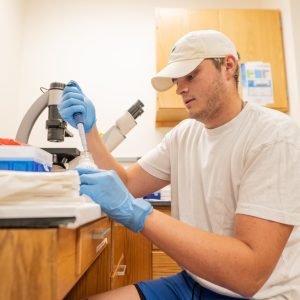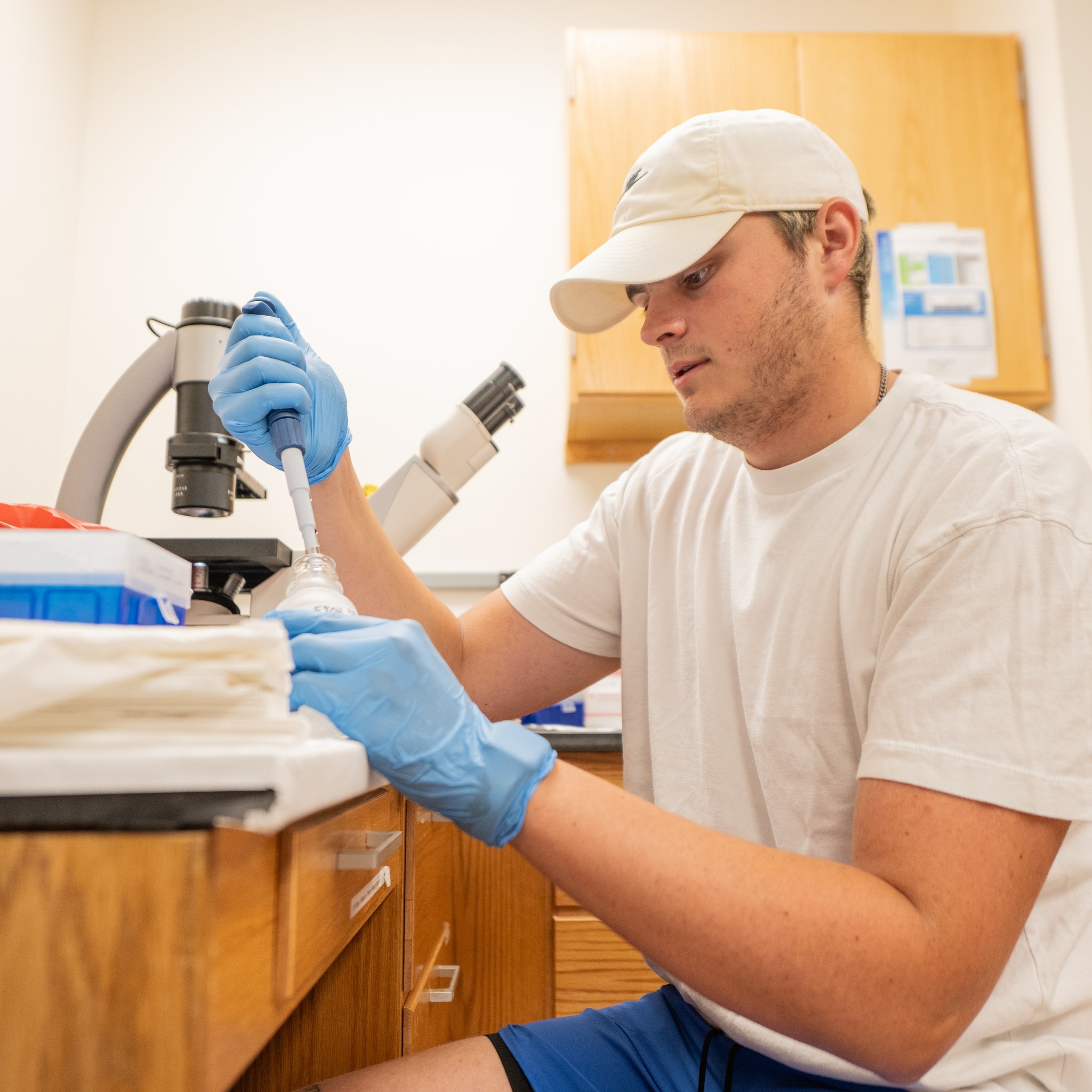This has been an exciting, eventful summer for DePauw science. Since the graduation of the class of 2023, many labs across campus have been hard at work pipetting, imaging, and surveying. Two labs, however, have been doing truly remarkable work within the Chemistry and Biochemistry department and the Biology department. Animesh Dali, class of 2024, and Ryan Miller, class of 2025, took me through a culmination of the past four months of their work.
Dali, in the lab of Dr. Daniel Gurnon and Dr. Sharon Crary, accomplished some interesting feats in his Chemistry lab. The title of their project, Investigating Mutant Variants of the Unspecified Significance of LDHA, may be daunting to some, but Dali was comfortable as a rising senior with countless hours of lab experience. Dali explained in an interview, “The LDHA enzyme, lactate dehydrogenase, could be mutated in various people. Some mutations can be deleterious and cause problems such as fatigue and muscle pain.”
This enzyme is at the center of their focus, playing a pivotal role in the functioning of our bodies. When someone with a novel mutation arrives at a clinic, the clinic will report the mutation to ClinVar, a database that stores various genomic variations and their symptoms. For example, he continued, “P139L is code for Proline (an amino acid) becoming Leucine (an amino acid) at residue 139.” This is how information in the biochemical world is communicated. Dali and his lab investigate how P139L and other LDHA mutants affect the activity of the LDHA enzyme.
To investigate this change, Dr. Gurnon and Dr. Crary’s lab expressed the wild-type and mutant variants of the LDHA protein by transforming E.Coli using a plasmid. The protein is then extracted and purified. Kinetic runs are then performed to observe absorption based on changes in substrate NADH. Based on the rate of NADH usage, the effect of the mutation is determined.
Their goal this summer was to pinpoint the effect of a certain amino acid change in a patient, so physicians can prescribe and anticipate what effect will be exhibited in the patient. How is it going, you ask? Well, Dali explains that this is a tedious process with numerous intricate details, and the lab will be working for many more months in their quest to investigate amino acid changes.
Like Dali, class of 2025 student Ryan Miller has been hard at work. While Ryan is a rising junior, he is comfortable and skilled in the laboratory. In Dr. Sarah Mordan-McCombs’ lab, Miller has been conducting research on Characterization of Mechanisms of Action in Novel Cancer Therapeutics. Their subject, Miller explains, involves testing a novel drug in the use of treating various types of cancer. He began utilizing different concentrations of a benzyl amino alcohol, the novel drug, in a crystal violet density assay which shows cell density and concentration. Then, testing kidney cells as the control cells, and prostate cancer and breast cancer cells as the test, he used wound assays to record how various cell types reacted to the treatment. Miller explains, “This was a repetitive process with lots of trials and cell runs.”
As wound assays are at the core of their procedure, Miller took a moment to explain the steps. Heexplained that first the cell culture is grown, then various concentrations of cells are plated using a six-well plate. To wound the cells, a micropipette tip is drug across the well. After the cells are wounded, a microscope with 10X magnification is used to image the wells. Before, during, and after drug treatment, the cells are imaged to observe their response.
Miller’s group is interested in how the novel benzyl amino alcohol compound affects both healthy kidney cells and cancerous prostate and breast cells. After they record this novel drug’s effects, they can compare it to known chemotherapy drugs. If the cells respond similarly to the known drugs during wound assay, the two prove to be similar. The similarity between this novel drug and the known chemotherapy drug would signify a clinical application of Dr. Mordan-McCombs’ novel drug.

In just four months, this lab has reached a point where the results are being formulated. There is even a likelihood that these results are significant, an impressive result for Miller and the lab.
After countless hours in the lab, both Dali and Miller expressed lots of gratitude to both DePauw University and their respective professors who granted them an opportunity to gain invaluable experience. Looking to the future, Dali wants to work on the enzymatic degradation of plastics in the future, after gaining his Ph.D. The processes and components of this research are a good basis for his interests in the future and he looks forward to taking this research to various conferences across the country to educate scientists and research enthusiasts alike. Dali would like to thank Dr. Gunon and Dr. Crary for the opportunity to work in their lab.
Miller referenced the great success DePauw has offered to students regarding research, as well as significant research. He noted DePauw’s small school size, but big school opportunities. Finally, he thanks Dr. Mordan-McCombs for a supportive, positive, and formative lab environment.

